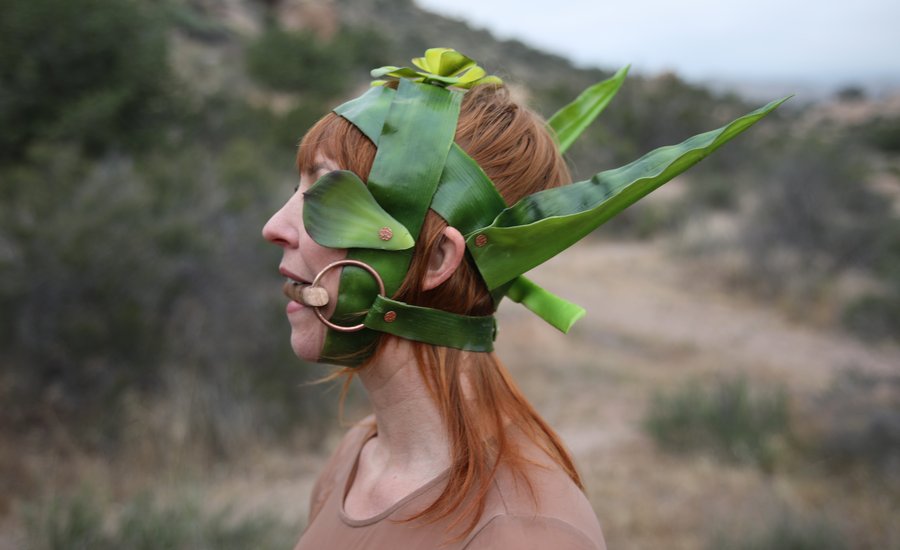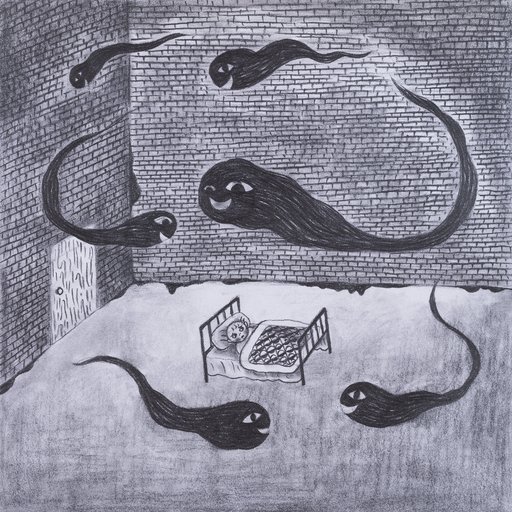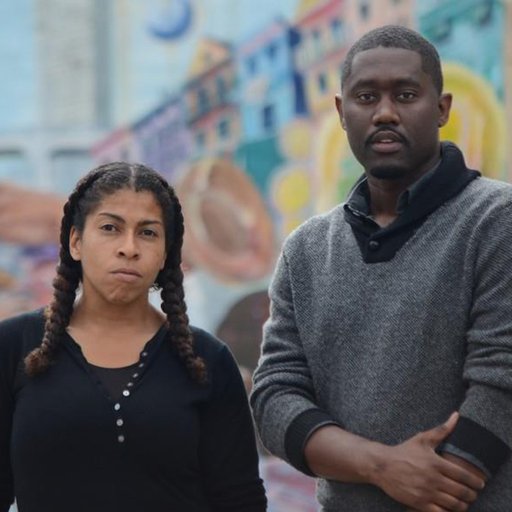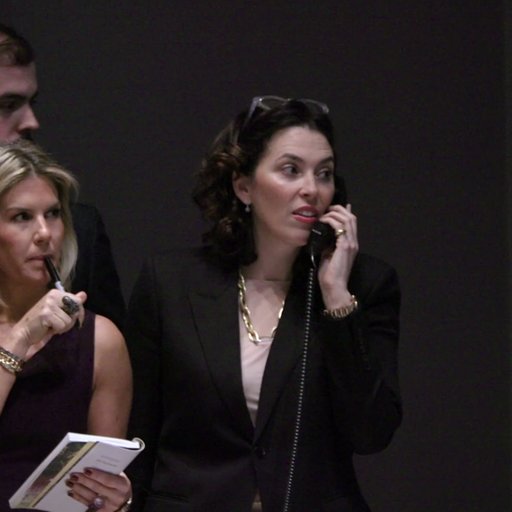For her first gallery exhibition, presented at Garden gallery in the artist's hometown of Los Angeles, Genevive Belleveau presented objects that, at first glance, look like things you might find in a botanical garden or spa retreat, like carefully arranged plants and hanging glass orbs. But look more closely to find that many of these objects aren't meant to just be visually pleasing; outfitted with penetrable orifices or penetrating obtrusions, these objects can be used for masturbation.
 Smol Succulent Anal Seed
. In collaboration with Themba Alleyne for Sacred Sadism. Image courtesy of the artist.
Smol Succulent Anal Seed
. In collaboration with Themba Alleyne for Sacred Sadism. Image courtesy of the artist.
Roughly a year ago, Belleveau and her husband Themba Alleyne launched an eco-fetishist sex toy line, Sacred Sadism, that combines floral aesthetics with BDSM, an erotic roleplaying practice involving bondage, discipline, dominance and submission, and/or sadomasochism. In addition to offering BDSM scenarios to clients, the duo also perform "vac-bed" rituals as art. A vac-bed (short for vacuum bed) is a device typically used within the world of BDSM where a person is sealed within a latex envelop, which after being completely sucked of air using a vacuum hose, leaves the participant constrained and immobilized. A hole in the latex over the mouth allows the participant to breath, while a heightened sense of sensation due to the vibrations of the latex make touch especially enjoyable.
In Belleveau's version, the artist carefully arranges plants and flowers over the nude model as they lie in the vac-bed. Once the process is initiated, the model is "pressed" like a flower, and the semi-transparent latex creates a tight, shiny surface over the body/plant arrangement. Photographed from above via drone, the resulting images are beautiful and strange. At Garden, the images, printed on a translucent substrate and coated in latex to mimic the process that generated them, are hung over windows. But for the artist, these photographs aren't the "meat" of the work. Instead, the negotiations, conversations, and relationships that made the photoshoot possible are what fascinates Belleveau.
The process begins with a conversation between the artist and her model about consent and safety protocol. A wiggling of the tongue acts as the "safe word," prompting Belleveau or her partner to immediately release the vac-bed and free the model—which could mean the photo session is over, regardless of whether or not the artist got the shot. "The tricky part is if I've done a floral arrangement on their body, it falls apart once you press it once," says Belleveau. "So there's a lot of patience involved in getting the images."
While Belleveau and Alleyne may have created a business out of their passion for BDSM, entrepreneurship was never the goal. Instead, Belleveau sees the business as a way to introduce people to the aspect of BDSM that interests her the most: its reliance on honest conversations about power and hierarchy, safety and consent. "I think literally every sector of human life on Earth could learn a lot from the kind of protocol and language that BDSM communities have been honing and getting really specific about for decades," says Belleveau. Still considered fringe, BDSM communities often subscribe to aesthetics—like dank dungeons, black leather, and spiky metal—that tend to off-put more than entice many people unfamiliar with the subculture. By crafting an artistic practice using botanical materials and softer, more gentler aesthetics, Belleveau makes the world of BDSM more visually appealing to the mainstream.
Here, we speak with the artist about why she feels it's so important to spread the gospel of BDSM, about how it can educate us about our relationships to power, and about how to conserve creative energy and create art out of constraint.
At Garden you performed a vac-bed session inside the gallery with an audience present for the first time. What was that like?
That was the first time it was done as a performance. It was a task performance, which in the world of theater art, means that you do a task, an you do it in front of people, and if it's done with intention and grounding, it's going to be interesting to watch no matter what you're doing. I did a floral arrangement on the model, who was a friend of mine who had already modeled for the vac-bed portraits. It was important to work with someone who was familiar with the experience and was excited to be there. I also wanted to highlight the way that the vac-bed can be used for BDSM play, so once my friend was sealed in the vac-bed I used some of the flowers to do some sensation play, a little bit of impact play, and a sort of… I want to say 'soft-dom' because it wasn't a really heavy dominatrix vibe, but a kind of soft-doming sensation play.
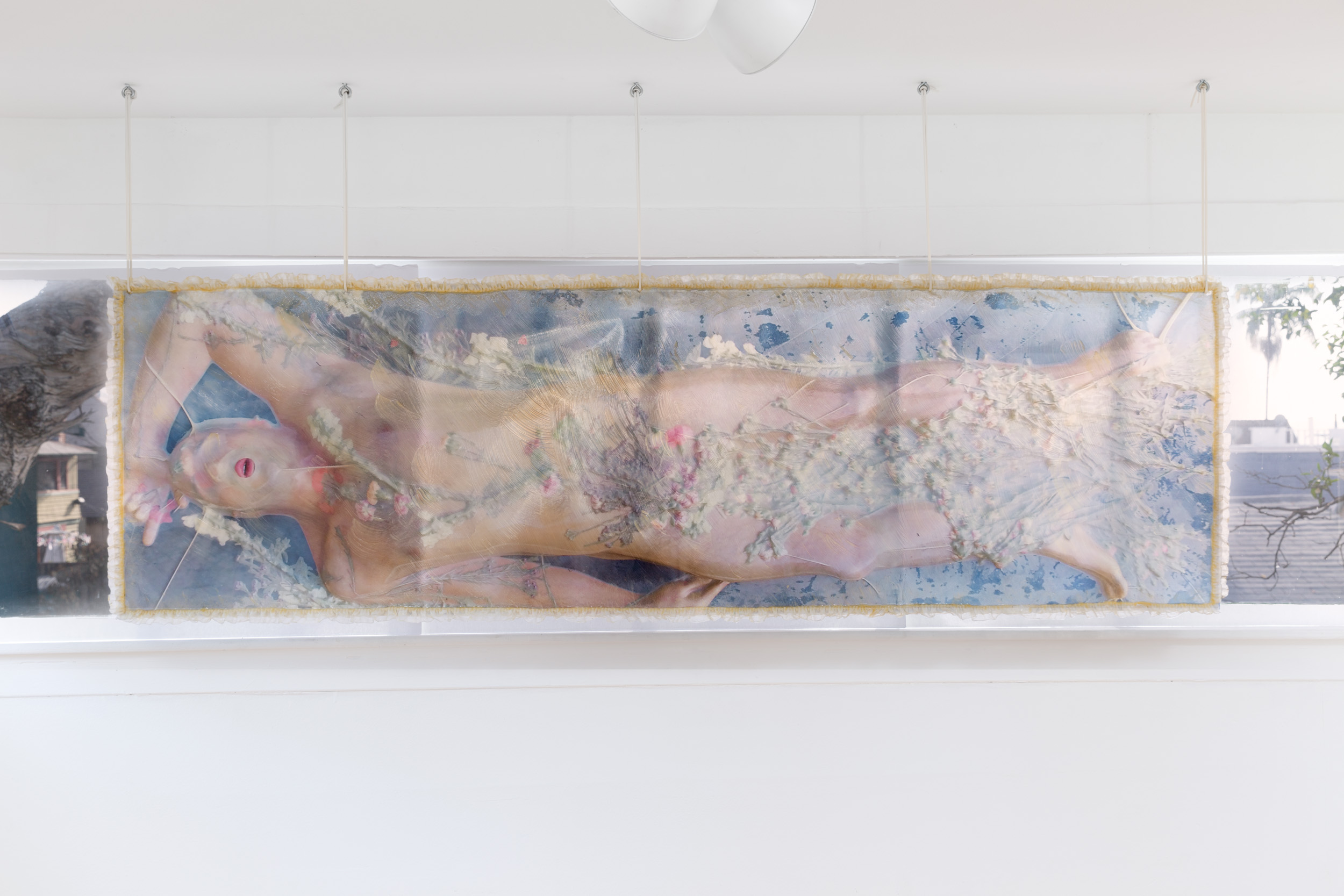 Pressed Matthew
(2018). From Circlusion at Garden LA. Image courtesy of the artist.
Pressed Matthew
(2018). From Circlusion at Garden LA. Image courtesy of the artist.
The body in these works becomes flattened—kind of literally in the vac-bed—and then flattened again two dimensionally as an image and as an object. I'm wondering if you can speak to how objectification relates to what you do.
Objectification is a type of BDSM play; I've always found that to be really interesting. In terms of mainstream and pop culture, I think a lot of people think of objectification as a women being treated as a sex object. In BDSM, when all players consent and agree to what's happening, there's a bunch of different kinds of objectification scenarios that can exist. In the world of eco-fetishism, which is the catch-all term I use to describe these plant-inspired BDSM scenarios, objectification means putting someone in the headspace of a flower, which is interesting because flowers don't really become objects until they're cut for humans to arrange. In the arrangement the model becomes just another pressed flower.
 Pressed Kyla
(detail) From Circlusion photo series 2018. Photo courtesy of the artist.
Pressed Kyla
(detail) From Circlusion photo series 2018. Photo courtesy of the artist.
The exhibition is called "Circlusion." Where does that term mean and why is it interesting to you?
A friend of mine introduced me to the term ‘circlusion,’ which I looked into and there's really only one piece of information on it online and it’s by Bini Adamczak, who is a writer based in Germany. The term means the same thing as penetration but looked at from a different perspective. I thought that idea was so important, and important to my practice, because all of the things that I've been doing for the past five years or so are about power and how power is exchanged consensually and non-consensually with each other and with the natural environment. It was interesting me to reimagine a power dynamic that has been so immortalized as this one thing, penetrative sex. Not that the essay is only about that, but it does focus on how penetration has become this very heterosexual thing where sex equals this and not that. What circlusion asks is: what if we think about sex and gender differently? In the research I've been doing about power exchange, partnership, and domination, ‘circlusion’ seemed like a really important word for me to confirm a feeling that I had: that there's another way to shift the conversation on how we view power and sexual exchange.
For “Circlusion,” the show, I wanted to bring in these tools that kind of look similar in a sense to the tools we create for Sacred Sadism, which are impact play tools, which means tools you use to hit people for BDSM scenes or sensation play. We created handles and tools that look very similar and echo the aesthetics of the pressed flower vac-beds, but instead of illustrating violence, impact, and hitting—things that people might associate with BDSM—these are tools that have actual masturbation sleeves imbedded in them. To be enclosed by is itself an active position to be in.
When looking into your work I was reminded of an amazing quote that I had read… but I have no idea who wrote it or what exactly I said because I couldn’t find it anywhere. [Laughs.] But from what I remember, it was a critique on how the term 'consent' is used. 'Consent' is, for good reasons, a buzz word right now; it's being used a lot in sex education, for example. But the word, or at least how it's typically used, usually assumes a passive women consenting to an acting man. So not only is it gendered, it’s also suggesting that consenting means submitting, giving in, allowing something to happen to you. It’s a passive term. It’s in contrast with will or desire—or action. In other words, ‘consent’ is associated with a response or a reaction rather than a proposal or a desire. That really resonated with me, and I think it resonates with your work and with this idea of circlusion. So much of your work is about consent, but I think it’s opening up more room for a more active reading of it.
I think that's a really, really good point because consent does assume a passive role and an aggressive role in a sense; one person is a dominator and one person is willing to be dominated. Another foundational level of my work thinks about hierarchies of power and how they exist and are activated in our daily lives, and how this idea of domination is really what runs the show. We are inculturated with the idea that domination means power, even when that power might not be authentic or might not have been generated from consensual exchanges. That's why BDSM interests me so much.
BDSM has been around for a long-ass time and ethical players in the community—people that are deeply engaged in conversations of power and consent—consent that all parties, no matter what their roles are, are all on the same page about what's going to happen. And that doesn't mean that misunderstandings don't happen because humans are human and they can't always communicate as clearly as they'd like to. But it means that there's a protocol, a best practice, a safe consensual practice, a risk aware practice. I think literally every sector of human life on earth could learn a lot from the kind of protocol and language that BDSM communities have been honing and getting really specific about for decades. I think there's a lot of really… not just rich material, but in my mind, really revolutionary thinking in those spheres.
Part of what I'm trying to do in creating this aesthetic world, which is very recognizable stylistically, is to invite people into those conversations that have existed in BDSM scenes for so long, though a visual doorway that for some people might be easier to pass through. A spoonful of sugar makes the medicine go down.
 Angiosperm’s Milk
(2018). From Circlusion at Garden LA. Image courtesy of the artist.
Angiosperm’s Milk
(2018). From Circlusion at Garden LA. Image courtesy of the artist.
Your Sacred Sadism objects have like, spa vibes, which I think are very easily consumed, especially by those who are into self care—another buzz word/millennial zeitgeist. I think such a big part of self care is about performing it. Not just doing it, but posting an image of you doing it, showing how much you engage in self care; it’s a display of projected self worth. But somehow sex, or even just pleasure, isn’t really part of that performance in a mainstream, visible way. People are much more comfortable sharing sexy selfies, images that make them sexualized, but passive—able to be consumed and desirable. There’s this interesting thing going on with your work where you’re exploiting the most relatable, sharable, accessible, beautiful aesthetics in order to do something more subversive, in order to normalize conversations about pleasure and sex and BDSM. It's like, oh right, having desire, desiring, is normal; it's not only bout being desirable. You’re like, Trojan Horsing BDSM into #selfcare. Not that you’re tricking people...
…No, no it is absolutely a trick! [Laughs.] It's a trick but not with ill intentions. It's to ask people to look at their own relationship to power and hierarchies of power. Because if you get engaged with BDSM in an ethical way you can educate yourself about how you relate to power. I'm still learning, my partner is still learning, and hopefully everyone else in the scene leaves themselves room to learn and grow because there's a lot to explore.
After working on this project for years and years I finally launched the Sacred Sadism line a year ago with my partner, Themba Alleyne, who makes the tools. In the second year of running the business, what we really want to be doing is running a bait-and-switch. We've got people into the tools, but we don't really want the tools to be ‘the thing.’ I want to take the platform that we've built and start to bring more of these dialogues about power to the forefront—to make it less about the objects and more about how are we using these objects to actually interrogate these other questions. That's what I hope the second phase of the project will be.
The sense that I get is that you're very good at turning certain constraints or frustrations into something productive artistically. Speaking from my own experience as an artist living in New York, I'm constantly frustrated with the lack of time I have for my studio practice, or feeling like I don’t have the physical space I need to be productive, or feeling like I can’t find solitary spaces to “tune out” and recharge. You've done projects that solve some of these problems, for instance you made a sanctuary in a mobile home, you've made a kind of collaborative artist residency in Minnesota...
... Well it’s similar to you guys and your gallery in your backyard [Hotel Art Pavilion]! I've always loved that project. I did a performance series in my backyard, where I created a church in a shed. It’s that thing of needing to create out of the constraint; constraints can be such a wonderful tool for creation.
I read somewhere too that you had a job working in a Mister Softee's Ice Cream truck, and you used that as relational aesthetics platform as well. So I'm just wondering if you have any advice for other artists who feel like their artistic practice is limited by life getting in the way—whether it's needing to have a full-time job, or needing to live in a big city when they're not really a city person, or whatever. Spirituality seems to be a big part of your practice, so filling that need might fit into this question too. How have you managed to make it work for yourself?
What a good question but I don't know... I feel like it might just be something intrinsic to my character—my need to express through any means possible. For example, the church that I did in the shed came from thinking, fuck, I’m not finding the social scene that I want, which involves spirituality, creativity, and congregation, literally. I'm not finding that so I'll just make it. Honestly some of the best advice came from one of my mentors, Laura Parnes, who was my video art professor in college and I assisted her for many years afterwards. Her advice to me when I was a senior in college was: Don't worry about being accepted into any scene, make your own scene. That is something she did. She created Momenta Art in Williamsburg and was able to harbor a space for all these other artists. So that really stuck with me as a go-to. Do your own thing, don't wait around for other people to stamp you as a good artist, a bad artist, a true artist, a fake artist, whatever. Just let it happen.
Granted I have a lot of privilege and a lot of foundational things that were set up for me to be able to do all the things that I've done. That's something that I have to acknowledge and people have to acknowledge about themselves. But yeah, just make your own scene. Don't wait around. I've had years go by of doing what would appear to be nothing but I was engaged in smaller projects that I was really happy with but that weren’t seen or acknowledged or noticed. Not everything is going to be groundbreaking. I was really happy and am still very happy with those things that I made during those quieter periods.
Do you have a day job?
I'm a server at a restaurant. I work probably 15 hours a week and I'm able to live on that. I live a very low-budget lifestyle and I have a lot of free time, which again, is a privilege. I can walk to work (which in L.A. is a huge thing), put in my time, and I don't have to think about it when I leave. It's nowhere near my mind. All the rest of my time can be put towards creative activities. Maybe that's a part of what has made my practice work for me—that I've never put that much emphasis on or had very much pride in my day job. I didn't try to become a gallerina or have an arts admin job or something that would make me feel like I looked good professionally. I just worked the jobs that allowed me to eat, or at times was just really poor and had food stamps or whatever. A professional career had never been of any importance to me because I don't think my purpose on Earth is to accrue wealth.
RELATED ARTICLES:
"I Want to See the Devil in Us All": How Robert Mapplethorpe's Queer BDSM Redefined Photography











